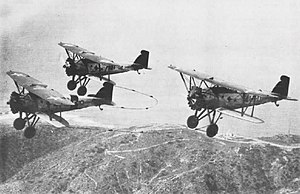| F2B | |
|---|---|
| Boeing F2B-1, Photo by U.S. Navy | |
| Role | Carrier-based Fighter |
| Manufacturer | Boeing |
| First flight | 3 November 1926 |
| Introduced | 20 January 1928 |
| Primary users | U.S. Navy Japan, Brazil |
| Number built | 32 plus 1 prototype |
| Developed from | Boeing XP-8 |
Contents
|
Design and development
Initially the Boeing Model 69, it was inspired by the results of tests on the FB-6, which was powered by a Pratt & Whitney R-1340B Wasp radial engine. Boeing set out to use this engine in a fighter designed specifically for carrier operations, using the same welded-tubing fuselage and wooden-frame wings as for the Model 15, and adding a large spinner to reduce air drag around the engine (this was dropped in production). Armament was either two .30 cal. machine guns, or one .30 cal. and one .50 cal.; the lower wing had attachments for up to four 25-pound bombs, plus a fifth could be hung from the fuselage.[2]Operational history
First flight of the F2B prototype was 3 November 1926. The Navy acquired the prototype as XF2B-1, which was capable of reaching speeds of 154 mph, and was sufficiently impressed to order 32 F2B-1s. In addition to omission of the spinner, the production versions also had a balanced rudder. Delivery began 20 January 1928, with some assigned to fighter squadron VF-1B and others to bomber squadron VF-2B, both operating from USS Saratoga (CV-3). Although the Navy did not order any more F2Bs, Boeing built two more, as Model 69Bs, exporting one to Brazil and the other to Japan.[2]In 1927, the US Navy with the help of US Marine officer Lt. D. W. Tomlinson, created the first official US Naval aerobatic team. Drawing from VB-2B squadron at Naval Air Station North Island, San Diego, the team used three Boeing F2B-1 and F2B-2 fighters. Its first demonstration in January 1928 at San Francisco gave rise to a popular nickname: "Suicide Trio" although officially the team was called "Three Sea Hawks". The first public performance was on 8–16 September 1928, during National Air Races week at Mines Field (now Los Angeles International Airport). The Boeing F2B-1 was unable to fly inverted without the engine quitting, consequently Lt. Tomlinson modified the carburetors to permit brief inverted flight. At the end of 1929, the Three Sea Hawks team is disbanded when its VB-2B pilots were reassigned.[3]
Variants
- Model 69
- XF2B-1, one prototype serial number A7385[1]
- Model 69
- F2B-1, single-seat fighter biplane for the US Navy, serial numbers A7424-A7455[1]
- Model 69B
- Two aircraft, generally similar to the F2B-1, one each to Brazil and Japan.[4]
Operators
Specifications (F2B-1)
Data from "The Complete Encyclopedia of World Aircraft" [4]
General characteristics- Crew: 1
- Length: 22 ft 11 in (6.98 m)
- Wingspan: 30 ft 1 in (9.17 m)
- Height: 9 ft 2.25 in (2.81 m)
- Wing area: 243 ft² (22.57 m²)
- Empty weight: 1,989 lb (902 kg)
- Max takeoff weight: 2,805 lb (1,272 kg)
- Powerplant: 1× Pratt & Whitney R-1340-8 Wasp Radial, 425 hp (317 kW)
- Maximum speed: 158 mph (137 knots, 254 km/h)
- Cruise speed: 132 mph (115 knots, 212 km/h)
- Range: 315 mi (274 nm, 507 km)
- Service ceiling: 21,500 ft (6,555 m)
- Rate of climb: 1,890 ft/min (9.6 m/s)
- Guns: One 0.5 in (12.7mm) M2 Browning and one 0.3 in (7.62mm) forward firing M1919 Browning machine guns or two 0.3 in forward firing machine guns in the forward fuselage
- Bombs: Five 25 lb (11.3 kg) bombs carried under the fuselage and lower wing
 Unknown
Unknown









0 komentar:
Post a Comment